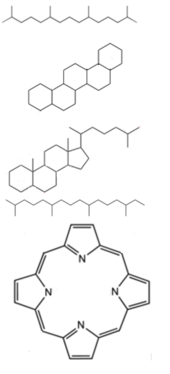바이오마커(석유)
Biomarker (petroleum)화학 및 지질학에서 바이오마커는 탄소, 수소 및 기타 원소 또는 산소, 질소, 유황과 같은 이질성 물질로 구성된 모든 복합 유기 화합물 모음으로, 원유, 비투멘, 석유 자원 암석에서 발견되며 결국 모든 리브에서 발견되는 모 유기 분자로부터 분자 구조가 단순화된 것을 보여준다.잉그 유기체본질적으로, 그것들은 이전에 살아있는 유기체로부터 파생된 복잡한 탄소 기반 분자들이다.[1]각 바이오마커는 유기물이 원유로 전환되는 데 필요한 시간이 신중하기 때문에 상대 바이오마커에 비해 상당히 특이하다.[2]대부분의 바이오마커들도 대개 분자량이 높다.[3]null
석유에서 발견되는 바이오마커의 예로는 프리스탄, 트라이테르판, 스테레인, 피탄, 포르피린 등이 있다.이러한 석유 바이오마커는 생화학적 화합물을 주요 성분으로 사용한 화학 합성을 통해 생산된다.예를 들어, 트라이터패널은 육지 혈관조영식물에서 발견되는 생화학적 화합물에서 파생된다.[4]석유 바이오마커의 풍부함은 그 저장장치나 원천 암석에 소량의 석유 바이오마커는 그러한 화합물의 존재를 분석하기 위해 민감하고 미분적인 접근법을 사용할 필요가 있다.일반적으로 사용되는 기법에는 기체 크로마토그래피와 질량 분광법이 포함된다.[5]null
사용하다
석유 바이오마커는 석유 검사에서 매우 중요한데, 이는 석유 검사에서 퇴적지를 나타내고 석유의 지질학적 특성을 결정하는데 도움을 주기 때문이다.예를 들어, 그들은 그것의 성숙도와 원천 재료에 관한 더 많은 세부사항을 제공한다.[6]게다가 그것들은 또한 좋은 연령의 매개변수가 될 수 있기 때문에 기술적으로 "화학 화석"[7]이라고 불린다.프리스탄 대 피탄(pr:ph)의 비율은 석유 바이오마커들이 퇴적 환경의 성공적인 지표가 될 수 있는 지질학적 요인이다.[8]null
지질학자들과 지질학자들은 원유와 그 관련 원천 암석들에서 발견되는 바이오마커 흔적을 사용하여 현재 존재하는 석유 매장량의 지층적 기원과 이동 패턴을 밝혀낸다.[9]바이오마커 분자의 분산은 또한 기름의 종류와 그 원천에 따라 매우 독특하기 때문에, 그들은 독특한 지문을 보여준다.석유 바이오마커의 선호도를 높이는 또 다른 요인은 환경 풍화 및 부식에 대한 내성이 높기 때문이다.[10]그러한 바이오마커는 매우 유리하며 주요 수로의 기름 유출 탐지에도 자주 사용된다.[1]동일한 바이오마커를 사용하여 윤활유 오일의 오염을 확인할 수도 있다.[11]그러나 처리되지 않은 암석 절단물에 대한 바이오마커 분석은 잘못된 결과를 초래할 수 있다.이는 암석 표본의 탄화수소 오염과 생물분해 가능성 때문이다.[12]null
참조
- ^ a b Wang, Z.; Stout, S.; Pinggas, M. Environmental Forency, 2006 7, 105-146.
- ^ Stevens, Douglas; Hsu, Chang Samuel; Shi, Quan (2013). "Petroleum biomarkers analyzed by atmospheric gas chromatography-tandem mass spectroscopy" (PDF). Waters.
- ^ Osadetz, K.G; Pasadakis, N.; Obermajer, M. (2002). "Definition and characterization of petroleum compositional families using principal component analysis of gasoline and saturate fraction composition ratios" (PDF). Energy and Resources. 1: 3–14.
- ^ Hsu, Chang S.; Walters, Clifford; Peters, Kenneth E. (2003). Analytical advances for hydrocarbon research. pp. 223–245.
- ^ Niessen, Wilfried M.A. (2001). Current Practice of gas chromatography-mass spectrometry (1 ed.). pp. 55–94.
- ^ Chosson, P; Lanau, C; Connan, J; Dessort, D (1991). "Biodegration of refractory hydrocarbon biomarkers from petroleum under laboratory conditions". Nature. 351 (6328): 640–642. doi:10.1038/351640a0. PMID 2052089.
- ^ Wang, Zhendi; Stout, Scott A. (2007). Oil spill environmental forensics: fingerprinting and source identification. pp. 1–53.
- ^ Roushdy, M.I.; El Nady, M.M.; Mostafa, Y.M.; El Gendy, N.Sh.; Ali, H.R. (2010). "Biomarkers characteristics of crude oils from some oilfields in the gulf of suez, egypt". Journal of American Science. 6 (11). S2CID 55952894.
- ^ Head, Ian M.; Jones, Martin; Larter, Steve R. (2003). "Biological activity in the deep subsurface and the origin of heavy oil" (PDF). Nature. 426 (6964): 344–352. doi:10.1038/nature02134. PMID 14628064.
- ^ Ashton, Buffy M.; East, Rebecca S.; Walsh, Maud M.; Miles, Scott; Obeton, Edward B. (2000). "Studying and Verifying the Use of Chemical Biomarkers for Identifying and Quantitating Oil Residues in the Environment". Journal of Ocean and Climate Systems: 1–54. S2CID 201925529.
- ^ Bieger, Tilman; Hellou, Jocelyne; Abrajano Jr., Teofilou A. (1996). "Petroleum biomarkers as tracers of lubricating oil contamination". Marine Pollution Bulletin. 32 (2): 270–274. doi:10.1016/0025-326X(95)00151-C.
- ^ Ratnayake, Amila Sandaruwan; Sampei, Yoshikazu (2019-06-01). "Organic geochemical evaluation of contamination tracers in deepwater well rock cuttings from the Mannar Basin, Sri Lanka". Journal of Petroleum Exploration and Production Technology. 9 (2): 989–996. doi:10.1007/s13202-018-0575-8. ISSN 2190-0566.



